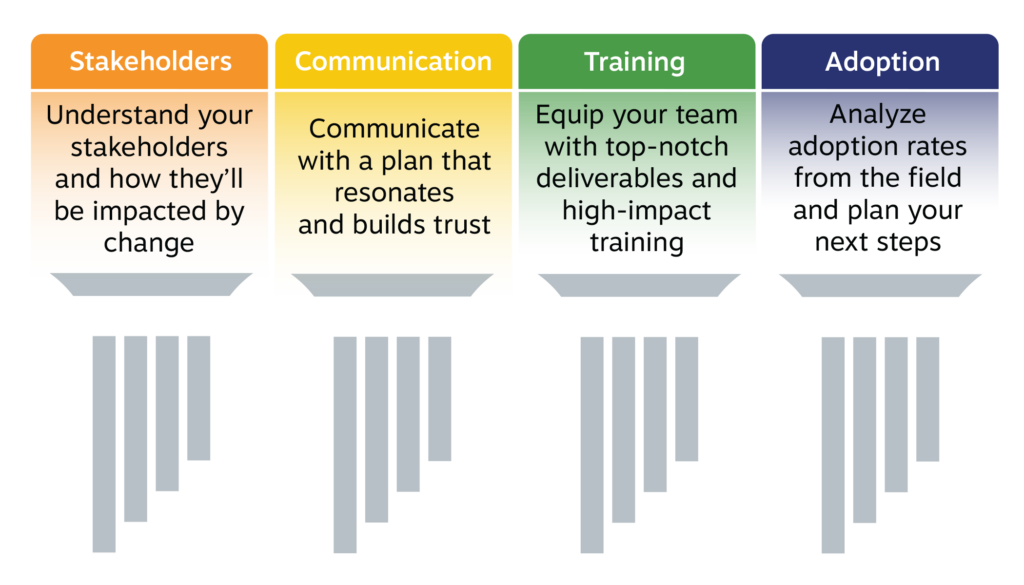We’ve all had them—those projects where everything seems to be going right. Your project team and executive all see the value it will bring to the company. They’re excited for the positive impact it will have on your workforce. Everything is shaping up perfectly for go-live and then bang: your initiative grinds to a halt on roll-out. There are many reasons projects don’t go the way you were hoping. Some factors are out of your control, but there’s one important thing you can control: Change Management.
In fact, Change Management can be the key to a project succeeding or falling short.
What is Change Management?
Change Management is exactly what it sounds like. It’s the practice of managing change. The success of any project that impacts your people’s day-to-day hinges on how willing those people are to buy into the change.
No matter how brilliant your project is or how much ROI you think it will deliver, if you can’t convince end-users to feel just as excited about it as you are, your hard work will have been for nothing.
So how do you get Change Management right?
Methodologies
Change Management has been studied for decades and several leading methodologies have emerged as best-in-class:
- Accelerating Implementation Methodology (AIM) manages change by identifying and overcoming personal and cultural barriers using an agile approach
- ADKAR Methodology uses five steps to implement change and identify where resistance may come from so it can be mitigated early from an end-user perspective
- Kotter’s Change Method is an eight-step approach that focuses on bringing a team of collaborators together and getting buy-in from everyone involved
- Lewin’s Change Model uses the concept of unfreezing, changing, and refreezing to understand organizational change
Each has its own strengths and weaknesses, as you would expect. We’ll do a deeper dive into them in later blogs in this Change Management series. But they’re all focused on the same thing—overcoming resistance to change and making sure the right people are doing the right things.
Axsium’s Four Pillars of Change Management
You’ll remember from our recent process improvement blog series that Change Management is a vital part of implementing process improvement ideas, but the same is true for every project or initiative.
Over the years, we’ve developed our own approach to Change Management. This approach, based on our years of experience helping our clients deliver successful WFM projects, is based on four pillars: Stakeholders, Communication, Training, and Adoption.

Potatoes and Tomatoes
We’ll be digging more deeply into each pillar over the coming months, so for now I’d like to present two fictional retailers we’ll be following through each blog. Let’s call the two companies We Sell Tomatoes and We Sell Potatoes.
Both sell produce items. They’re both are sizable retailers with over 250 stores and 10,000+ employees. And both are implementing a new WFM system. But here’s the crucial difference—We Sell Tomatoes is prioritizing Change Management in their project; We Sell Potatoes is not.
Both retailers will need to find a way to help their managers and on-the-ground staff understand the new scheduling processes and clocking systems. More than this, they’ll need to make sure everyone is actually using those systems—and using them properly.
But there’s more to think about than just end-users. The administrative teams will need to learn new processes that will significantly shake up their workdays. Your forecasting specialists will suddenly have a lot of new data and they’ll need to know what to do with it.
Over the next few blogs in this series, we’ll look at our Stakeholders, Communication, Training, and Adoption approach. We’ll highlight what these two companies will do differently and see how those different approaches will affect each of their projects.
What Now?
For now, here are some questions to ask yourself if you’re trying to decide if you need to think about Change Management.
- How much does the success of your project rely on buy-in from associates, managers, and head office staff?
- Have you actively engaged members of each group in your planning process?
- Who are the staff who will support those impacted by your project and help to drive adoption?
- Will your project’s business case still be a success with 50% end-user adoption?
Major projects come with a lot of moving parts—there are so many elements to plan. But without the right people adopting your project and making it part of their workday, you’ll find success very difficult.
And remember, Axsium’s Change Management experts are here to discuss any questions you have.
